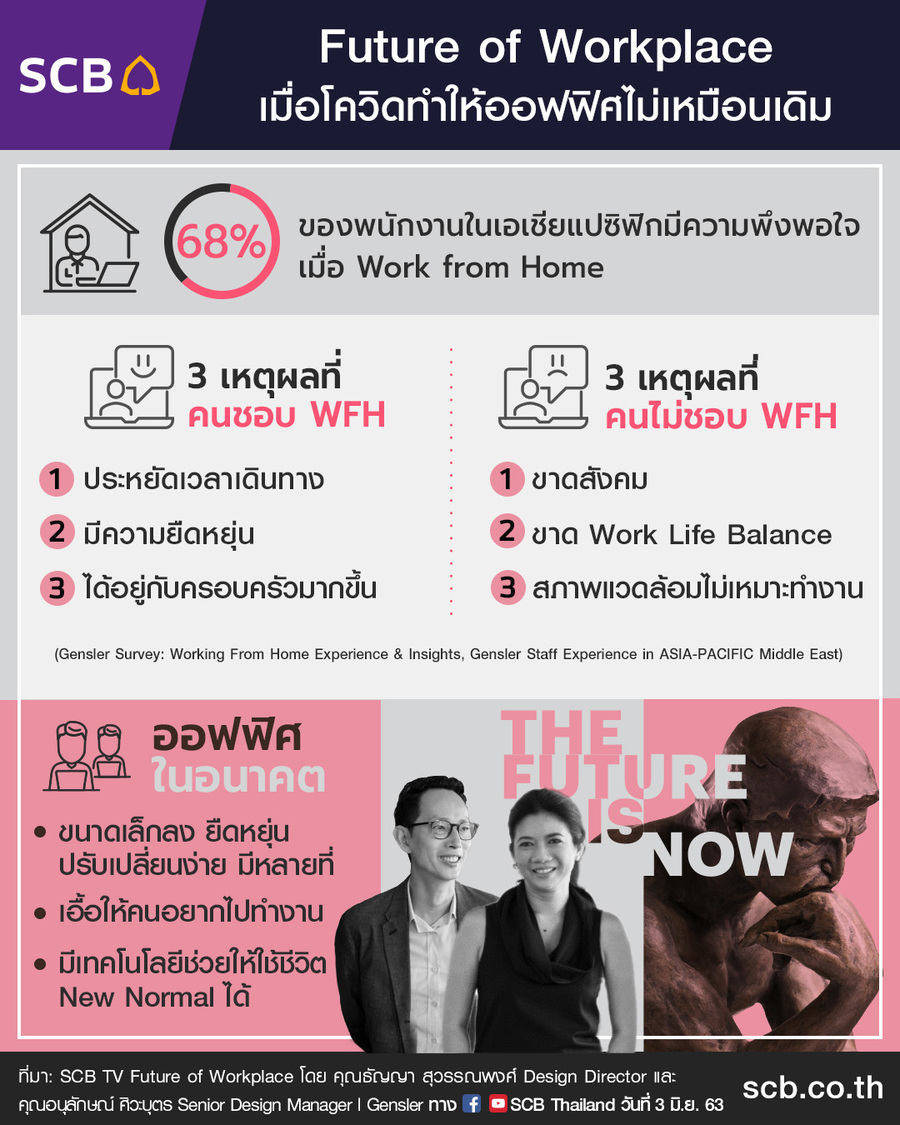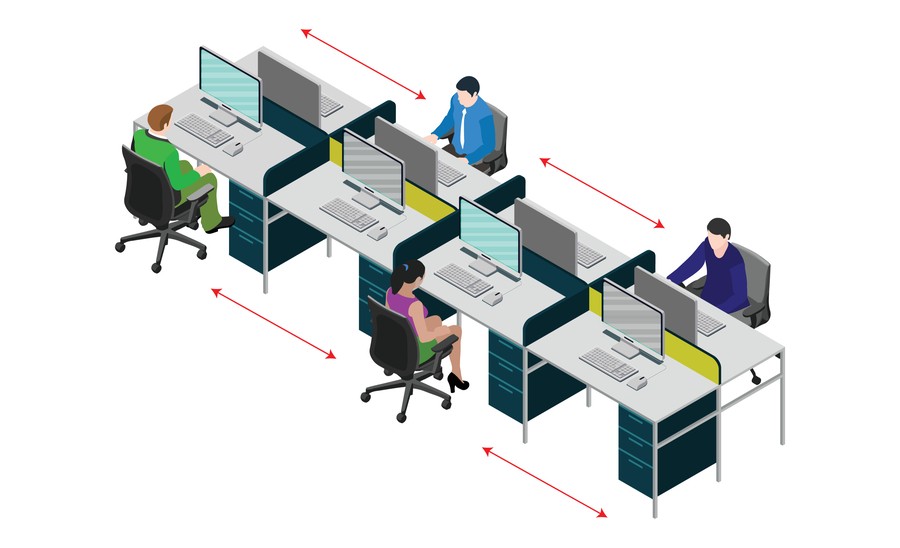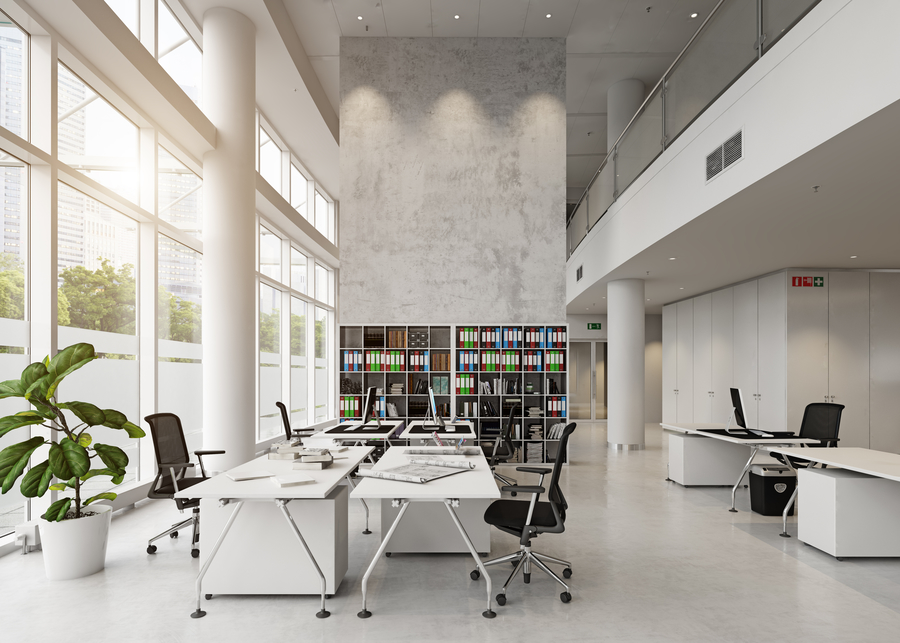I WANT
RELATED LINKS
I WANT
RELATED LINKS
RELATES LINKS
I WANT
RELATES LINKS
Services
Related Links
Use and Management of Cookies
We use cookies and other similar technologies on our website to enhance your browsing experience. For more information, please visit our Cookies Notice.
- Personal Banking
- Stories & Tips
- Salary Man
- Future of Workplace
- Personal Banking
- ...
- Future of Workplace
Future of Workplace
15-06-2020
Covid-19 has changed the entire office worker lifestyle. K.Tanya Suvannapong, Design Director, and K.Anulak Siwabut, Senior Design Manager of Gensler, the world architectural design and consulting company, shared their design perspective after Covid-19. Also, a large working space downtown may not be an answer. Moreover, the Work from Home during Covid-19 pandemic research shows a significant change of the future working pattern.

How Covid-19 changed the meaning of offices?
The result of the Covid-19 outbreak, many organizations allow their employees to work from home. K.Tanya said that this pandemic made “Work” apart from “Place” as everyone around the world is affected. When Work from Home happens, the question that when we will come back to the office also happens, what will the organization culture be from now on, how is the safety and security be, also happen. From these questions, the organization needs to prepare a proper solution for their employees. K.Tanya told us that there are 4 basic office designing fundamentals which are daylight, movement, well-being, and interactive.
Currently, there are 3 office patterns; 1. In an agile workplace where is flexible and agile, employees could gather around and share ideas or split into a small group. 2.Activities base workplace (ADW) which is the office pattern based on each function needs and consists of a variety of activity areas. 3.Co-working space which is initiated from Startup group to share the area with other startups to get more collaboration and sharing.

The reason why Asia-Pacific people loves Work from Home
As Covid-19 outbreaks, Gensler company surveyed their employees' experience satisfaction with Work from Home situations and found a 78% response rate. K.Tanya summarized the result as 68% of Asia-Pacific employees satisfied with Work From Home compared to other regions. It is higher than in Europe and China. Also, Sydney, Australia has the highest score of 91% and the least is from Tokyo, Japan at 59%.
The reason why the score from the Asia-Pacific region is high at 96% is that they feel secure and being trusted by their boss and they know the expectation from their bosses. 67% said that it is about being power agile with better work results. 50% gets a better family relationship especially the family with teenagers is more satisfied than other kids age ranges.
The top 3 satisfying Work from Home reasons are 1. Transportation time saving 2. Flexible work and 3. More family spending time. However, the unsatisfying reasons are 1. Lack of socially interactive and missing colleagues 2. Lack of work-life balance because they cannot totally separate work and rest and 3. Lack of proper working environment and equipment. Moreover, the result shows that the work from home satisfaction rate is higher when a proper environment and facilities are provided. So, the organization shall facilitate and provide those as needed for a more effective work from home situation.

Office Pattern after Covid-19
Certainly, after easing the lockdown, most offices may let their employees back to the offices. K.Anurak said that the company shall design their area based on the new normal situation as below,
1. The Entrance
The separation between employees and visitors is needed with a check-in point for temperature checking, a social distancing guide, and a preventive sign in the building.
2. The measures for a one-story building
No two-way path with additional physical distancing guide. Direction sign and safe environment for employees.
3. The measures for two-story or more buildings
Fire exit stairs are recommended instead of elevators to reduce touching and also direction signs are needed.
4. Working area
Keep distancing or crosswise sitting without directly facing each other. This makes insufficient working areas as before, so working shift arrangement is needed. In the case of working table sharing, cleaning is a must with a cleaning sign in order to ensure employee’s trust.
5. Air ventilation is needed for closed room
whether personal working rooms, meeting rooms. Social distancing for the meeting room and online meeting facility is needed.
6. Pantry or kitchen
Social distancing for eating area and no food sharing. Also, fewer chairs and cleaning measures must be implemented.
7. Outside area
Providing for employee’s relaxation with social distancing measures.
K.Tanya added that the most important thing is people often forget when they are gathering together. So, a warning sign for social distancing, direction, and keeping good hygiene is needed. However, sign designation shall be stress-free and can make people smile. This is also necessary apart from area arrangement.

Why do we still need an office, we already work from home.
Many leading companies start permanent work from homes such as Facebook or Twitter. The next question is, is the office still necessary in the future while this work from home trend is coming? K.Aunrak told us that the office is still necessary because 1. Organizational culture conservation means showing their core value, knowledge, technology, reputation, and organization faith. 2. Keeping an engagement between internal and external relationships. 3. Customer service support, from Gallop research, shows that working-friend relationship results are better than no-relationship working. So, it is better to have an office for colleague engagement in order to continue the organization's culture.

What will the future workplace look like?
As we believed that an office is still necessary, so what will the future workplace look like? K.Anurak said that the future workplace features shall include these; 1. The New Neighborhood: The area can be adjusted and flexible based on working activities. 2. Meet Market: As most people are working from home, so the organization should have a connecting point for meeting and discussion. Over one area is recommended in order to be more convenient. 3. Digital Wonderland: In the future, the office shall implement new technology with respect to a new normal working style. Also, to solve many problems and enhance working efficacy. For example, interaction-reduction technology whether Facial Recognition door opening, and electrical and air-conditioner adjustment via Wi-Fi.
K.Tanya also added that in the future office area should be flexible and easily changed in case of the spread of infectious diseases. The office should be a favorite destination for working. Not by force but for their satisfaction. Moreover, work from a home policy will be implemented onward after the Covid-19 pandemic.
Finally, what about working designations for different generations? K.Tanya told us that there should be options for each generation's functions and purposes. Not only one desk fixes all styles which is an old-fashioned way. K.Anurak also added that the offices could not be the same because of Covid-19. Furthermore, we shall prepare for new technology to be added to the building. So, the future design is not only about functions but also flexibility and satisfies employees with more good hygiene, and prevents any future risks.
Reference: LIVE SCBTV Future of Workplace: The offices were changed by Covid-19; by K.Tanya Suvannapong, Design Director, and K.Anulak Siwabut, Senior Design Manager of Gensler via Facebook SCB Thailand 3 June 2020
